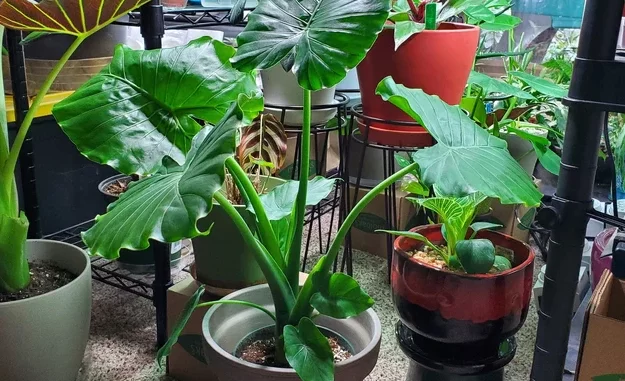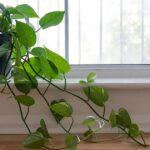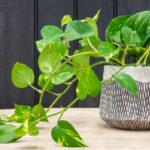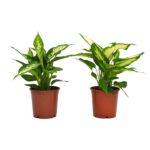
Last Updated on by Sabina
Alocasia, commonly known as Elephant Ear plants, are tropical beauties renowned for their large, striking leaves that resemble elephant ears. With their dramatic foliage and unique growth habit, Alocasias add a touch of exotic allure to any indoor or outdoor space. In this comprehensive guide, we will explore the fascinating world of Alocasia plants, providing insights into their growth requirements and essential care tips for cultivating these captivating specimens.

Getting to Know Alocasia
Alocasia Varieties
There is a wide array of Alocasia varieties available, each with its distinct leaf shapes, patterns, and colors. Some popular varieties include amazonica, zebrina, and macrorrhiza. Take time to explore the different options and select the variety that speaks to your aesthetic preferences.
Striking Features
Plants are known for their grandiose leaves that can grow to impressive sizes. The leaves exhibit intricate vein patterns, unique textures, and a vibrant range of colors, including various shades of green, silver, purple, and even black. These eye-catching features make Alocasias a captivating addition to any plant collection.
Optimal Growing Conditions
Light Requirements
Alocasia plants thrive in bright, indirect light. While they can tolerate some direct sunlight, it’s best to provide them with filtered light to prevent scorching of the leaves. Place your Alocasia near a window with a sheer curtain or in a spot with bright, indirect sunlight to ensure optimal growth.
Temperature and Humidity
Alocasias are tropical plants and prefer temperatures between 65°F and 85°F (18°C and 29°C). They are sensitive to cold drafts and temperature fluctuations, so it’s important to keep them away from chilly windows or doors. Alocasias also appreciate high humidity levels, so consider misting the leaves regularly or using a humidifier to create a suitable environment.
Soil and Potting
A well-draining soil mix is crucial for the health of Alocasia plants. Use a blend of peat moss, perlite, and well-aged compost to ensure good drainage and aeration. Alocasias prefer slightly acidic to neutral soil pH (around 5.5 to 7). When potting, choose a container with drainage holes to prevent waterlogging and potential root rot.
Watering and Feeding
Watering Routine
Alocasias prefer consistently moist but not waterlogged soil. Water your plant when the top inch of soil feels dry to the touch. Ensure thorough watering, allowing excess water to drain away. Avoid letting the plant sit in standing water, as it can lead to root rot. Adjust the watering frequency based on the season and environmental conditions.
Fertilizing Requirements
Alocasia plants benefit from regular feeding during the growing season (spring and summer). Use a balanced, water-soluble fertilizer diluted to half the recommended strength. Apply the fertilizer every two to four weeks to provide essential nutrients for healthy growth. Reduce or halt fertilization during the dormant period in winter.
Alocasia Varieties
Plants offer a wide range of varieties, each with its own unique characteristics and visual appeal. Here are a few popular varieties that plant enthusiasts often seek to add to their collections:
Alocasia amazonica: Also known as Polly or African Mask, this variety features distinct arrow-shaped leaves with dark green coloration and prominent silvery-white veins. The contrasting patterns make it a striking choice for indoor spaces.
Alocasia zebrina: Recognizable by its elongated, arrow-shaped leaves with prominent veins resembling zebra stripes, Alocasia zebrina adds a touch of exotic elegance to any setting. The leaves have a deep green hue and are often complemented by purple undersides.
Alocasia macrorrhiza: Commonly referred to as Giant Taro or Elephant’s Ear, Alocasia macrorrhiza lives up to its name with massive, heart-shaped leaves that can reach impressive sizes. The glossy, deep green foliage adds a tropical flair to gardens and larger indoor spaces.
Alocasia odora: Alocasia odora is appreciated for its large, lush leaves that can grow up to 3 feet long. The foliage is a vibrant shade of green and emits a delightful fragrance, especially in the evenings. This variety is often favored for its ornamental value and aromatic presence.
Alocasia frydek: frydek, also known as ‘Green Velvet,’ showcases velvety, emerald-green leaves with prominent silver-white veins. The foliage has a soft texture, and the compact size of the plant makes it suitable for smaller indoor spaces.
Alocasia cuprea: cuprea, commonly referred to as Jewel, boasts striking metallic copper-toned leaves with a glossy sheen. The leaves have an almost iridescent appearance, adding a touch of glamour and opulence to any plant collection.
Alocasia sanderiana: Alocasia sanderiana, also called Kris Plant or Krispy Wave, features uniquely shaped leaves with undulating edges that resemble a saw blade. The foliage has a dark green coloration and prominent veining, making it an intriguing addition to indoor spaces.
These are just a few examples of the diverse Alocasia varieties available. Each variety brings its own aesthetic appeal and unique foliage characteristics, allowing plant enthusiasts to find the perfect Alocasia to suit their preferences and complement their indoor or outdoor environments.


